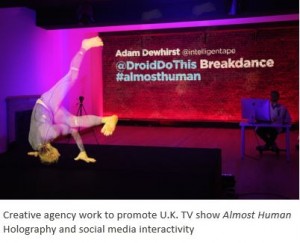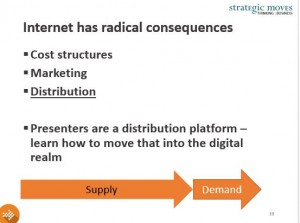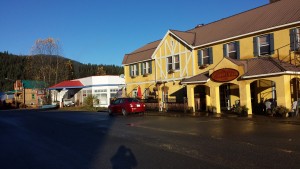
The Wells Hotel
I spent Thanksgiving in the Cariboo town of Wells, BC (population 259) at the Northern Exposure conference.
Here are my reflections on what we did, how we did it and what it enabled; in so doing I hope to draw the curtain back a little on effective design thinking-inspired meetings that help people move to the next level – whatever that is for them.
Putting the team together
Island Mountain Arts‘ ambitious conference attracted about 75 festival organizers, arts organization staff and volunteers and musicians from BC’s northern and southern interior, the Sunshine Coast, Vancouver Island, Haida Gwaii, and the Yukon.
Island Mountain Arts (IMA – named after a local mountain, called Island) has been operating its renowned Summer School of Art since 1977 and over the years has expanded with a Public Art Gallery and Gift Shop, an International Harp School, the Toni Onley Artists’ Project and the award winning ArtsWells Festival of All Things Art.
Julie Fowler, Executive Director of IMA, invited me to facilitate this conference, based on my previous work with SPARC – Supporting Performing Arts in Rural Communities and the Yukon Arts Presenters Summit. And she recruited co-presenters and panelists from across B.C. to ensure a wide range of perspectives.
A common purpose: creating community
Speaking with Julie, we quickly established a common purpose: to build up a better networked rural festival and arts community.
My approach as facilitator and presenter was focused on creating spaces for participants to get to know each other, share knowledge and know-how, and encourage collaborative learning and action planning. Julie and her wonderful team took care of conference logistics, meals and showcases – 16 in total – at the local Sunset Theatre and the Wells Hotel. She arranged two sessions tailored for musicians.
The conference also had its share of great food by chef Sharon and the kitchen crew and a fine assortment of beverages at showcase and reception venues. Being in a small place, the conference moved as a whole from breakfast at the Wells Hotel to the Wells Community Hall for conference sessions, back up the street for lunch and showcases and then back for more learning. We shared dinner and conversations and then went off to the Sunset Theatre for showcases. A late evening snack invariably appeared at the Pub to maintain the stamina of musicians and participants alike.
I feel that having participants move together in this way, sharing meals and conversations in ever changing configurations, made for closer connections and more meaningful, relevant learning.
Pre-conference professional development
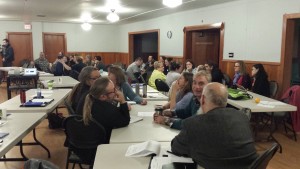
Participants during the audience development session.
The pre-conference professional development day on audience development was attended by most of the conference participants. I delivered a well-honed workshop; modified as usual to suit the rural context. This session was highly interactive, with lots of conversation by all participants and practical learning. This was followed by a full slate of 15-minute 1-on-1 sessions with me. The nine participants brought a wide range of marketing and organizational questions to these intensive conversations.
At the same time, Emma Jarrett, a performance coach, conducted a fantastic hands-on workshop for musicians and anyone else interested in honing their presentation skills.
Creating an open learning environment
I borrowed a networking exercise from the Yukon Arts Presenters Summit (Let’s Get Connected) which in turn the Yukon organizers had modified from SPARC. The four topics were:
• who you are and what you do
• your hopes and dreams
• what you’re seeking
• what you have to offer
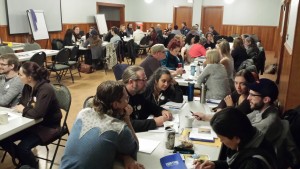
During the Let’s Get Connected process, participants had four 10-minute segments for reflection and conversation at tables of 6 each. A quick way to meet 20+ participants in an hour.
All participants had their picture taken at registration. They recorded the information on their print outs and then discussed it with their group. Every 10 minutes a room full of participants stood up and found a new table of six to move to the next topic. It’s an amazing free-flowing choreography.
With the sheets we created a Living Wall that served as a reminder of the breadth and depth of knowledge and experience each and every participant brought to this conference.
It was a powerful beginning that I feel set the tone for a true working conference: Participants heard their own voices from the start; felt valued as experienced organizers; and they became collaborators in co-creating our conference.
After a short coffee jaunt up to the hotel, I gave a well-received keynote on Co-creating a Culture of Place, in which I made the case, as I have at other conferences, for Vibrant communities fueled by the arts and its community-engaged partnerships. Much of the data in that keynote comes from The Value of Presenting study. This study continues to deepen the conversations about arts presenters and their role and impact in their communities.
After lunch, I had the pleasure of working with Janet Rogers – a Mohawk/Tuscarora writer and broadcaster from the Six Nations in southern Ontario, who was born in Vancouver and has been living on the traditional lands of the Coast Salish people (Victoria, BC) since 1994 – to share information and lead a conversation on Cultural Tourism. I provided context and laid out a cultural tourism landscape. Janet led a conversation on how to access indigenous artists for festivals and events, and encouraged making the necessary contacts early in the event planning process. She proposed that in so doing we could move from the acknowledgement of traditional lands into meaningful inclusion and full participation by indigenous and non-indigenous artists. After all, Aboriginal tourism is seen as a key aspect of expanding Canada’s and BC’s cultural tourism potential.
I felt this was an important and open conversation about an area many of us want to get right but also feel some insecurity about. These protocols are new to most event organizers. What excites me is that meaningful change can happen through our individual decisions and actions, by getting to know each other and speaking openly and respectfully to each other. We don’t have to wait until everything is figured out in the big picture.
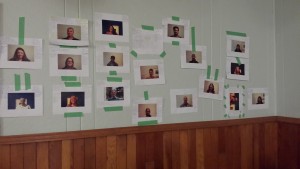
A small selection of our Living Wall.
Concurrently, Music BC presented a session for musicians on all of the sources of revenue available to them for their work.
I moved the programmed afternoon networking round tables outside to a walking conversation – thankfully the rain held off and the winds had died down.
Sharing stories and action planning
On the last day of the conference we were in Barkerville.
The morning featured five inspiring stories presented by Julie Fowler, ArtsWells Festival/Island Mountain Arts; Carla Stephenson, Tiny Lights Festival; Karen Jeffery, Sunset Theatre; Deb Beaton Smith, Rifflandia; and Miriam Schilling, Xatśūll Heritage Village, Soda Creek.
The panelists – participants conversation drew the curtain back a little on how to build success, how to sustain arts in small communities and the kind of perseverance, experimentation and serendipity it takes. Everyone was eager to share their experiences and it felt like the perfect transition to move toward action planning.
But first I led a practical workshop on integrated online marketing with Fraser Hayes‘ able assistance. Fraser is the station manager of CFUR Radio in Prince George; a community radio station that has built a substantial integrated online footprint to complement its broadcasts. More insights and specific action items tumbled forth and then we were ready for lunch, a walk about this amazing restored gold rush town and the final two showcases.
The conference concluded with action planning. First I asked everyone to write down key take-aways from the conference, their next action steps and desired short and long-term results. The process requires participants to write the information out twice: one copy to take home and the second copy to be shared with participants. In this way we hope to facilitate network building. (I borrowed this format in condensed form from the Yukon Arts Presenters Summit which was facilitated by Jerry Yoshitomi.) Writing this down twice gives more time to reflect and form greater commitment to taking actions. This exercise moved seamlessly into a robust conversation around participant-identified topics. We collapsed about 10 (!) suggested topics into three broad areas: programming, operations and youth. Participants quickly gravitated toward their topic and a number of specific ideas for collaborations and resource sharing were brought forward.
Finally, in closing, we ended as we began: with participants having the last word through sharing highlights from their own action plans.
It seemed everyone felt confident that this conference was not merely the culmination of a long-standing dream, but that it would be the catalyst to move forward with closer ties between participants and their organizations from all over rural BC.
While the conference concluded officially, conversations continued into the night as some participants stayed for Thanksgiving dinner and more pub time.
More than a week after leaving Wells, these days continue to reverberate in me. I am grateful for the new connections, the new friends I made and for being part of this special community of festival and arts organizers.
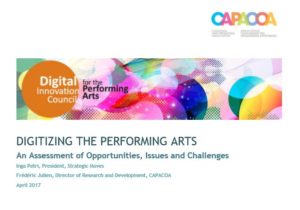
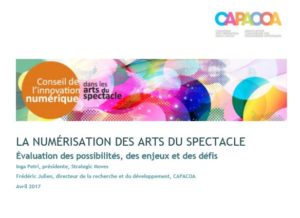 I hope that this assessment provides a springboard for new conversations and digital capacity in the presenting field.
I hope that this assessment provides a springboard for new conversations and digital capacity in the presenting field.
